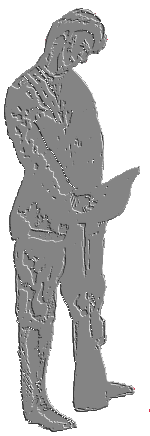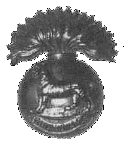 |
THE IRISH IN UNIFORM
THE MUNSTER FUSILIERS |
 |
| This image is a reproduction of part of a painting by Fortunino Matania, entitled "The Last Absolution of The Munsters at Rue de Bois, 1915." It depicts the blessing of The Royal Munster Fusiliers on the evening of 8th. May, by their Chaplain, Father Gleeson in front of a ruined shrine with a crucifix. Each Company has a green standard embroidered with an irish Harp and the word "Munster", gifts from Lady Gordon to the Regiment. |
|
The 2nd. Battalion attacked from their trenches at dawn the following day. The Commanding Officer, Colonel V.G.H. Rickard and his Adjutant, Captain Filgate both shown mounted on their horses in the painting, were killed during the action. In that battle on 9th. May, the Battalion dead numbered 381, including the C.O. and Adjutant. 11 medals were awarded regarding this action, and 2 recommendations made for the Victoria Cross. |
| The infantry
regiment which became known as The Royal Munster
Fusiliers was originally formed by the merging of two
other infantry regiments dating from the 1760's. These
were the 101st. and the 104th. Regiments of the British
Army, which had seen service mainly in India. There were
four regiments numbered 101 from 1760 to 1817 which
existed only briefly, and another Regiment called the
101st. gave over a century's service with The East India
Company from 1756 to 1861. This was in the days when military regiments were raised by their leaders or by trading companies and then gave service to governments when required. In 1861, the control of the 101st. passed from The East India Company to the English Crown. It remained a part of The British Army until 1922, when The Royal Munster Fusiliers as disbanded. Two of the early regiments bearing the number 101 had Irish connections. From 1794 to 1995, there was a regiment known as The 101st. (Irish) Regiment of Foot, raised by Colonel William Fullarton. In 1806, The 101st. (Duke of York's Irish) Regiment was raised, which saw service in the West Indies and Canada before being disbanded in 1817. The regiments numbered 104 had no Irish connections. They saw service in Canada and during The American War of Independence and were disbanded in Canada in 1817. Following the campaigns in The Americas, the regimental numbers 101 and 104 were taken over by The 101st. Royal Bengal Fusiliers and The 104th. Bengal Fusiliers, which saw distinguished service during the Indian Campaigns for well over a hundred years. Their battle honours included The Battle of Plassey in 1757, Delhi and Lucknow in 1857. The Victoria Cross Medal, the highest British award for bravery during military service, was awarded to 6 men of "The Bengal Fusiliers". A very unusual award of a small gold replica of The Victoria Cross was made to Mrs. Webber Harris, one of the 'regimental wives' of The Bengal Fusiliers, "for her indomitable pluck" during an epidemic of cholera in India in 1869. In 1881, following their return from India, the 101st. and the 104th. Bengal Fusilier Regiments were amalgamated and became The Royal Munster Fusiliers - the 1st. and 2nd. Battalions respectively. As this name denotes, "The Munsters" were recruited from Ireland's Southern Province of Munster, which is comprised of the Irish Counties of Clare, Cork, Kerry, Tipperary, Limerick and Waterford. During the 1914 - 1918 War, the Regiment grew to encompass 11 Battalions, with the 3rd. Reserve, the 4th. & 5th. Extra Reserve, the 6th., 7th., 8th., & 9th. Service Battalions and the 1st. & 2nd. Garrison Battalions being added to the 1st. & 2nd. Regular Battalions. At the outbreak of World War I, the 1st. Battalion of The Munsters was in Rangoon, Burma and went to join the 86th. Brigade of the 29th. Division in the landings at Cape Helles in Turkey in 1915. This was a fiercely-fought battle, during which Corporal William Cosgrove of County Carlow was awarded The Victoria Cross for conspicuous bravery. The Battalion suffered heavy losses during the campaign in Turkey, and for a short time the survivors were formed into a Battalion with those from The 1st. Battalion of The Royal Dublin Fusiliers - which was known informally as "The Dubsters". The 2nd. Battalion of The Munsters was in Aldershot Barracks, Hampshire, England at the outbreak of war in August 1914. They went to France with The British Expeditionary Force on 13th August as part of the 1st. (Guards) Brigade, 1st. Division; and later transferred to the 3rd. Brigade. The 2nd. Royal Munster Fusiliers, in their very first action in France, achieved a military feat unparalleled in modern warfare. A brigade may occasionally have the task of trying to delay a whole enemy division. A division may perhaps be deployed in an attempt to turn aside or halt an advancing army corps - but for a single battalion to stem the advance of an entire army by their sole action was unprecedented. In fact, less than a battalion strength, just 3 companies of the 2nd. Battalion of The Munsters halted the advance of the German Army for fourteen hours in the area of Oisny & Etreux during the retreat from Mons, thus enabling the rest of the British Army to withdraw to a safe distance of twelve miles. They were outnumbered at odds of over 6 to 1, and when finally defeated, the survivors were congratulated on their supreme bravery by the German soldiers they had fought. In 1922, a cross was erected in an orchard in Etreux, just behind the railway station, to the memory of 120 men of the Munsters's 2nd. Battalion who fell there in their last stand on 27th. August 1914. The officers and men of the Regiment who died in that battle are buried there alongside the carved monumental cross dedicated to their memory. Part of the inscription reads " In proud and lasting memory of ..... the officers, warrant officers, non-commisioned officers and men of the 2nd. Battalion, Royal Munster Fusiliers ..... who laid down their lives during The Great War in the cause of Freedom and Justice, 1914-1918" This 2nd. Battalion of The Royal Munster Fusiliers served in Flanders (Belgium) and in Northern France throughout the 1914-1918 War, including actions at Ypres, Festubert, Rue du Bois, Loos, The Somme, Passchendael, Le Catelet, Le Selle, Foret de Mormal and St. Quentin. They suffered particularly heavy losses in the battles at Festubert, Rue du Bois, Passchendael and St. Quentin. Many acts of bravery were acknowledged by the award of medals to the men of "The Munsters", and doubtless other incidents of heroism may well have gone unnoticed and unacknowledged in the chaos of war. Lieutenant A.H. Batten-Pooll of the 3rd. Battalion was awarded The Victoria Cross in August 1916 "for most conspicuous braveryw whilst in command of a raiding party on The Western Front". Company Sergeant-Major Martin Doyle, M.M., was also awarded The Victoria Cross "for conspicuous bravery near Reincourt on 2 September 1918". After the First World War, the 1st.Battalion went to serve in Silesia, Poland; and the 2nd. Battalion went to Alexandia in Egypt. In 1922, both battalions returned to England for disbandment. This esteemed regiment with a reputation for distinguished military service spanning over one and a half centuries and covering 3 continents was described as "one whose bones came from Bengal, but the blood and sinews - Irish", reflecting the bravery of the Irishmen of Munster from where the Regiment was raised. Acknowledgements of the bravery of the Irishmen of"The Munsters" were 50 "mentioned in despatches" and the granting of the following 198 medals: Officers - Companion of St.Michael & St. George (CMG) 1, Victoria Cross (VC) 1, Military Crosses (MC) 32, Bars to Military Cross 5, Legion d'Honneur (French Legion of Honour) 1, Distinguished Service Order (DSO) 6, Bar to Distinguished Service Order 2; Warrant Officers, Non-Commisioned Officers & Men - Military Cross (MC) 1, Military Medal (MM) 94, Bar to Military Medal 10, Distinguished Conduct Medal (DCM) 33, Bar to Distinguished Conduct Medal 2, Russian Cross of St. George 2, Albert Medal (Belgian) 1, Croix de Guerre (Belgian) 2, MSM (Military Service Medal) 4, Medaille Barbatie St. Credita, 3rd.Class (Awarded for service in Turkey) 1. More details of the Royal Munster Fusiliers Regiment can be found in the following publications:- "The 2nd. Munsters in France" by Lt. Col. H.S. Jervis, M.C., published by Schull Books, County Cork, Ireland 1998 , a reprint of the original published by Gale & Polden, Aldershot, England 1922 from contemporary records and memoires, a vivid account of soldiers' experiences of trench warfare in World War I, including reproductions of contemporary military maps. "The Irish Regiments 1683 - 1999" by R.G Harris, `published by Spellmount, Staplehurst, Kent, England 1989, (ISBN 1-86277-026-0) |
| Use this button to go to the Navigation Buttons at the top of this page. | |
This
site webcrafted for The Fame of Tipperary Group,
Tipperary Town, County Tipperary, Ireland by the WebWizards© at The
Plug-in Office ®,, e-mail to plugin@iol.ie All text, backgrounds, graphics, images Copyright © 2000 WebWizards or as acknowledged. |
|